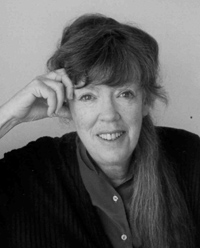

One of the great joys of recent years has been my collaboration with Enid Mark—writing poems not for some empty afterlife floating forever in the lost spaces of the internet, or appearing in a journal which next week will be recycled or used to prop a window, or in a paperback whose cover will curl on the first damp day—but seeing poems become part of an original and beautiful work of art, conceived in harmony with the words, handmade of enduring materials—so that the poems found a setting that dignified the language, that had a heft and texture and sensuous presence, and that rare book rooms might protect a while from the dustbins of time. And working with Enid provided, as well, the stimulus of an artist working in another medium who would lead me to think about and write what I would not have otherwise written, who brought good company into the isolation of the writer’s practice, who provided the pleasure of working with a visual artist who loves poetry, responds to what she reads, knows what she wants, and can tell—as we used to say—shit from shinola.
Over twenty years ago, long before I had met Enid, I received a request for permission for a poem from my first book, and later received a copy of two lovely pages from an artist’s book by Enid Mark called The Bewildering Thread, which contained poems about the womanly arts of the thread---spinning, embroidery, lacemaking, weaving—the tapestries in which women spoke before the page and the public stage were open to us. These arts of the thread are very much like poetry which is, after all, a weaving of lines—a kind of openwork, whose patterned lines let the light come through. It is those two images—the line or thread of meaning, and the light, that figure predominantly in this happy collaboration with Enid.
The latter image, that of reflected light, figures throughout our collaborations; the first book we made together, Precessional, in which she asked me for (and got) a transformed Greek myth in every poem--opens with her gorgeous lithograph of sunlight on water, and ends with the silver threads of moonlight on dark water. The moon returned in a later book to which I contributed, a volume starting, as she liked to do, with a Classical reference—this time the Hymn to Selene, which opens and closes The Inconstant Moon.
The next book, which neither of us ever suspected would be her last, Out of the Labyrinth, would return to the thread image with which her books began. It was Enid’s determined idea to do a book on the labyrinth, so this time the “bewildering thread” becomes the clew, a word referring to a ball of thread or yarn—in particular, in the Greek legend, where it named the golden thread given Theseus by Ariadne to use as a guide in and out of the labyrinth, to whose center he had gone to slay the Minotaur. I had no idea what I would write, but Enid’s mandate was, as usual, an invocation to the Muse, and so the poems appeared, following the thread out of the old story into the light of our own day. It was great fun to write those poems, and, with Enid, to pour over photographs and drawings, and watch the visual conception emerge—its connective image being luminous lithographs of a winding and unwinding spool of yarn, which will appear in the finished book, which Gene plans to see through to posthumous publication.
So that is a brief story of what began as a collaboration, and quickly became a friendship, and one which I treasure—in the books that came of it, and in the very present memory of the friend who created them—the elegance of her eye, her impeccable taste, her artist’s insistence on perfection of detail. I can still see with vivid clarity the day at the Philadelphia Museum of Art when Enid approached me after a reading and said, “How would you like to do a book together? Come visit my studio, and see what you think!” And I think of that visit, the light table in her studio, the way the interior light made the images glow. I was hooked. And what a great time we had together. I think I’ll end this little memoir with a poem, one that was, more or less, ordered up by Enid, when we were working on Precessional, giving each other clues for how to go on. She had just been struggling with a long poem of mine, too long for one page. “We need a poem about the cosmos,” she said. “But your poems are too long—no more fold-outs! So write me a short poem about the cosmos.” And so I did.
Eleanor Wilner
A Short Poem about the Cosmos --for Enid Dark out there. Cold. Dust glimmers, and stirs. Galaxies are born, form, spiral in a milky swirl of light: she stands at her window staring out, a breeze lifts the gauze curtain. An owl calls. She shivers a little, thinks of grey-eyed Athena, the useless wisdom in the aftermath of war, all the lost armies ghosts in iron masks--the Milky Way like armor atomized, gone to a shimmer of silvery dust: down to pure sheen, glory a scatter of glitter in the dust bin of time; out there--old fixities, old ardors retreating as the universe expands, just burning knots in an openwork of stars, the galaxies like torn lace curtains blowing in an empty room. In the northwest quadrant of the sky, she sees the comet, a dirty ball of ice thrown by some cosmic sprite, its brilliant tail a colloquy of dust lit by the hidden sun, life-giving sun, the star chance threw our way. She is shaken from her reverie by chatter from the room next door; the children must be playing games-- she almost shudders as she hears it's my turn now, followed by the clatter of the dice.